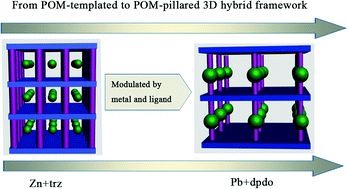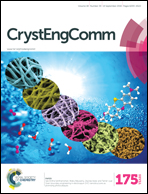Assembly of two novel 3D organic–inorganic hybrids based on Keggin-type polyoxometalates: syntheses, crystal structures and properties†
Abstract
Two hybrid materials based on Keggin-type polyoxometalate (POM), [Zn12.5(trz)17(H2O)7(SiW12O40)2]·2H2O (1) and (trz = 1,2,4-triazole) and [Pb2(dpdo)5(H2O)3(SiW12O40)]·H2O (2), (dpdo = 4,4′-bipyridine-N,N′-dioxide), have been hydrothermally synthesized and structurally characterized by elemental analysis, IR spectroscopy, thermal analysis, powder X-ray diffraction analysis and single crystal X-ray diffraction. Compound 1 contains 1D channels and giant cages occupied by Keggin-type POMs. Meanwhile, in compound 2, 2D coordination polymer sheets are constructed from Pb2+ and dpdo ligands which are further pillared by POM clusters into 3D porous frameworks with pcu topology. Interestingly, perpendicular to the 2D sheet, the dpdo ligands hang from both surfaces of the sheet; one end coordinates with the Pb2+ centre, while the other end is uncoordinated. Compounds 1 and 2 both show structural integrity in aqueous solutions in a wide pH range (from 2 to 12) and in common organic solvents (methanol and DMF). Moreover, the optical band gap, photocatalysis activity and electrochemical properties of both compounds have been investigated.


 Please wait while we load your content...
Please wait while we load your content...